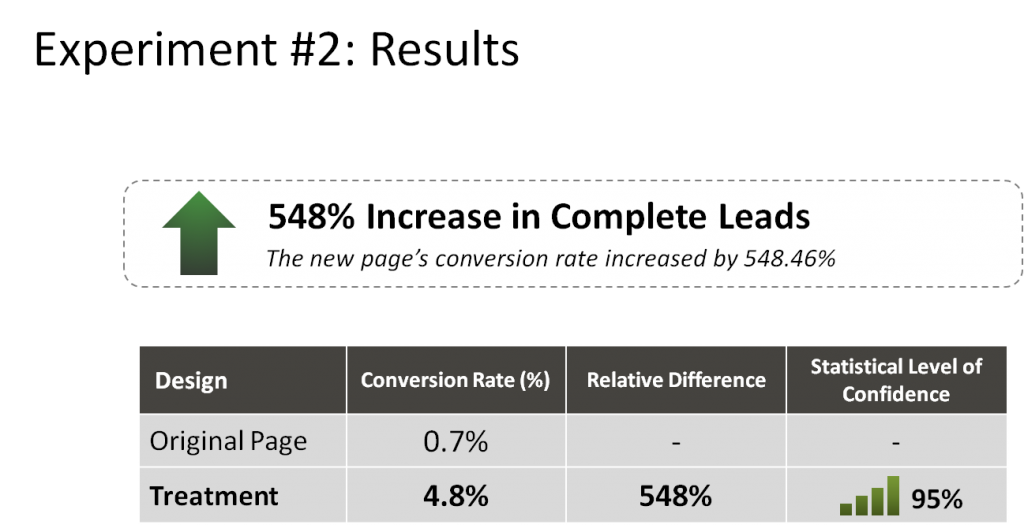 Dr. Flint McGlaughlin, CEO and Managing Director, MECLABS was the opening presenter of B2B Summit 2012 in Orlando.
Dr. Flint McGlaughlin, CEO and Managing Director, MECLABS was the opening presenter of B2B Summit 2012 in Orlando.
Flint’s presentation, “The Internet as a Living Laboratory,” introduced a case study showing how one B2B marketer used Web experimentation to generate a 90% lift in total leads.
In today’s MarketingExperiments blog post, we will take a look at the lessons you can learn from Flint’s presentation, highlighting an experiment that resulted in a 25% decrease in conversion.
–
The Background:
The MECLABS Research Partner in this study is an event management software firm which lets event coordinators create online registration forms and websites to manage their events.
The company’s goal was to increase the number of completed leads on the homepage. The focus of their testing was to determine which page will achieve the greatest addressable lead rate, and they set up an A/B split test to find out.
–
What went wrong?
What made this case study particularly interesting were the results of the experiment (or lack of positive results, I should say.)
The researchers hypothesized that a focus on the product-specific features and benefits would increase the products appeal. In the treatment they tested headline changes that focused more on the product, included specific features and benefits that express more product value, and ensured the value was communicated in steps.
Here is a picture of the control and treatment page, side-by-side.
–
The Results:
The control beat the socks off the treatment, and resulted in a decrease in conversion of nearly 25%. So, what can you learn from this experiment to help you learn from your own negative results?
–
Takeaway #1: Ask “why”
Ask “why,” no matter the test results, for as Flint explains, “Asking ‘how’ leads to information; asking ‘why,’ however; leads to wisdom. Marketers are all too busy asking ‘how.’”
Flint emphasized that test results should instead present questions of, “Why did the treatment decrease conversion by 25%?” and, “Why did more people say ‘yes’ to the control page?”
–
If at first you don’t succeed…
When the research team asked “why” instead of “how,” they realized that before they could get a lift, they needed a better understanding of the cognitive psychology behind the customer’s motivation. And, to get this understanding, the team decided to use one of the firm’s SEO landing pages, where they could test a smaller subset of visitors that matched the profile of the homepage traffic.
Testing on the SEO landing page also provided a testing environment that would not threaten the homepage conversion rate or validity of the results. Here is a screenshot of the SEO landing page control the team used in the second experiment.
–
–
And the treatment…
–
For Experiment #2’s treatment, the research team took what they had learned about the motivations of visitors to the SEO landing page and changed the focus from the previous treatment’s concentration on product features and benefits to a focus that features the product as a time saver that enabled creating registration forms faster.
–
The Results:
–
Flint clarified that by applying key optimization methodologies to the lead capture process, the treatment was able to improve step-level clickthrough rates by 1,312%, and completed leads captured by 548%. When the results of the SEO landing page were applied to the homepage, the treatment generated a 90% increase in leads captured.
–
Takeaway #2: Slow down in order to go faster
“Sometimes we need to slow down in order to go fast,” Flint added. He also explained that action is overrated and should be grounded in contemplation, while clarifying that contemplation without action is anemic and cautioning that ultimately action without contemplation is dangerous.
–
Takeaway #3: The marketer should be an organization’s philosopher
Flint built upon the point of slowing down in order to go faster by emphasizing that the marketer should be the philosopher of the organization. He added that the vigorous action of Sales needs to be grounded in the contemplation of marketing, saying, “Sometimes we need to think more deeply before we rush off to start campaigns.”
–
Related Resources:
Five Steps to Better Metrics – How one marketer leveraged Web analytics for an annual revenue increase of $500,000 (Web clinic replay)
Lead Testing: 90% of successful lead follow-up occurred within 28 days of first contact
Lead Generation: Phone calls turn first-time webinar into million-dollar leads
–








